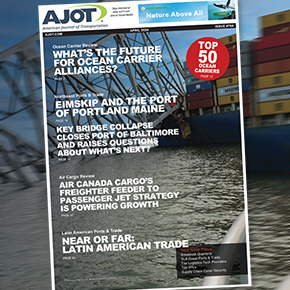Sea level rise could threaten California cities and ports by 2040
A new U.S. report, using advanced analytic software, says waves and storm surges are gaining momentum from sea level rise and collectively pose a more immediate threat than was previously believed. The result could be serious damage to California coastal cities and ports by 2040.
Elaine Forbes, executive director for the Port of San Francisco, told AJOT that rising sea levels are already threatening downtown San Francisco and Port property requiring the construction of a new sea wall (photo below). The projected cost is $5 billion.
The impact is similar to sea level rise driven storm surge damage suffered by U.S. cities and ports along the U.S. Gulf and Atlantic coasts from Hurricanes Katrina, Sandy and Harvey.
The United States Geological Survey (USGS) report, released on March 13th, projects a “likely” 0.25 meter or 9.8-inch sea level rise by the year 2040. The impact to California factoring “an extreme storm … would cause substantial flooding that would directly affect over 150,000 residents and $30 billion in property damage.”
The report says that a “future hypothetical, but scientifically plausible megastorm…would cause catastrophic inland flooding across California and property damage of over $300 billion.”
A USGS oceanographer, Juliette Finzi Hart, told AJOT: “The report incorporates new science that provides us with better projections because historical data is not as relevant when sea levels are rising. In California, wave energy adds to storm surge and rising sea level rise to create a stronger effect on coastal communities… This is happening sooner than expected… In California emergency services agencies are pretty savvy on the threats posed by sea level rise… On the Atlantic coast storm surge is more of a factor than wave energy so the dynamics are different but the threats are real for the Pacific, Gulf and Atlantic coasts… We are developing better prediction capability and this is helping cities and ports such as the Ports of Long Beach and San Diego better prepare. The improved science is also helping develop adoptive structures. Better standards are being codified by organizations such as the American Society of Civil Engineers.”

The USGS study cites two other reports that project damage from higher sea levels:
- The cost of protecting the San Francisco Bay Area from projected wave and storm surges based on a 2 meter or 6.5-foot sea level rise is projected to be as much as $450 billion. The 6.5-foot rise is not predicted until 2100, but the USGS study warns that previous sea level rise studies did not factor the impact of “long-term coastal change” that will be caused by the doubling of serious storms by 2040 compared to conditions present in 2000.
- California ports will need to spend between $9 billion and $12 billion on storm surge upgrades to defense against a 2 meter or 6.5-foot sea level rise by 2100, according to a 2017 report. The USGS report notes the collateral damage risk to the supply chain and infrastructure: “Beyond the potential physical impacts to the port terminals… that could impact the US’s ability to accept imports, coastal flooding and erosion will impact rail lines and roads exiting the ports, disrupting the movement of goods… throughout the United States.” Finally, USGS’s Hart notes that storms are increasingly coming from the South. This storm track will result in direct hits on the San Pedro Bay, the Ports of Los Angeles and Long Beach and the breakwater system that protects the ports.
The USGS study urges that more stress analysis be performed on the impact of increased flooding on the levees located along California rivers where “the engineering integrity of most of these structures is poorly understood.”
Over years, the Netherlands, directed by the government’s Rijskswaterstraat, has invested in a sophisticated sea level barrier system that had to be activated in January, 2018 to protect the City and Port of Rotterdam from flooding.
Texas is now proposing a Netherlands-type of sea barrier defense for Galveston Bay cities and ports that could cost $30 billion.
Coastal Storm Modeling System
The Coastal Storm Modeling System used for the USGS report “was designed to thoroughly assess future coastal flooding exposure by integrating SLR (sea level rise), dynamic water levels and coastal change.”
It can be used by planning, emergency services and insurance companies to make risk assessments for new and existing cities, ports, airports, highways, rail lines, bridges and levees. Local, state and federal emergency services agencies need to upgrade their planning to take into account intensifying damage from sea level rise beginning in 2040 and not 2100. The sea level rise threat is a world-wide threat: six hundred million people live in coastal zones around the world today and one billion will live in these coastal zones by 2050.
© Copyright 1999–2024 American Journal of Transportation. All Rights Reserved

